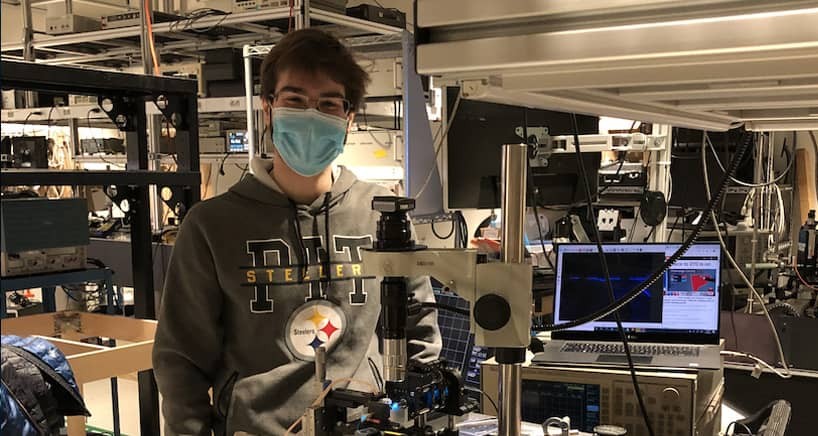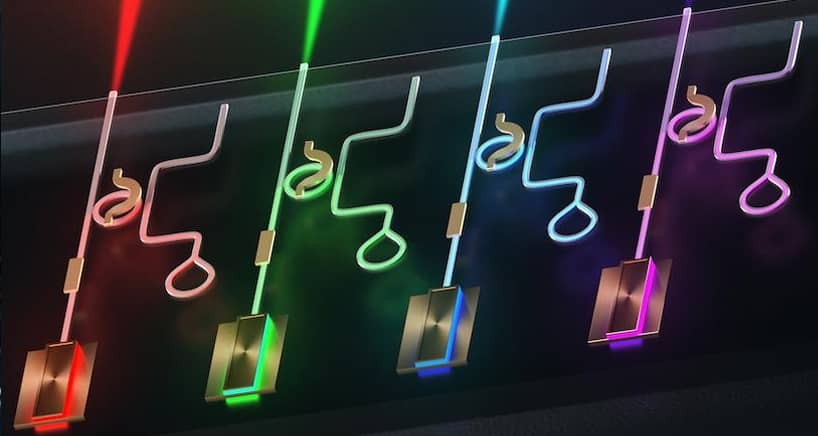In The Lab: Mateus Corato Zanarella
We sat down with the Electrical Engineering PhD student to talk about the new tunable laser platform he helped invent, the challenges of working with visible light, the importance of collaboration, and what he’s working on next.

Mateus Corato Zanarella is helping researchers see the light—literally. In Nature Photonics, the 6th-year Electrical Engineering PhD student and his colleagues in Michal Lipson’s nanophotonics group recently described a new kind of compact and inexpensive high-performance lasers that can be tuned to produce different colors of visible light for a wide range of applications from quantum optics to bioimaging.
Corato Zanarella came to the Lipson lab to work on photonic integrated circuits for his PhD, after completing his undergraduate and master’s degrees in electrical engineering at the University of Campinas in the state of Sao Paulo, Brazil. Always interested in science—physics in particular—he chose the major because he felt it was the most physic-y of the engineering sciences.
There, he started studying light. At first, by figuring out how to shape it in very unusual ways in free space before moving on to building optical fibers and integrated circuits. “In particular, I am very interested in visible light—because we can see it! It has a certain beauty to it, in addition to the interesting physical phenomena and math behind it,” he said.
We asked Corato Zanarella about the new tunable laser platform, the opportunities and challenges of working with visible light, and his future plans.
Why are visible light lasers interesting?

Most current photonic platforms operate at telecom wavelengths, which are very useful for data transmission and communications. But the field has started moving towards visible wavelengths for a range of other applications, including quantum information, biosensing, imaging, and more.
For example, because visible light can be modulated really fast, you can use it for wireless optical communication to supplement the saturated radio-frequency links at the user end of a network. You also need red, green and blue light for laser displays to form rich images of multiple colors. To develop underwater LiDAR technologies, you also need green and blue lasers, since ocean water strongly absorbs all other wavelengths. In biophotonics, fluorescent imaging and optogenetics use fluorophores and opsins that are excited with visible light in order to generate images and control neural responses respectively. For quantum optics, researchers need to be able to very precisely target atomic transitions with different colors of pure visible light, which vary from atom to atom.
All these potential applications require scalable, tunable, and narrow-linewidth visible light lasers, but the current options are big and very expensive.
When I first joined the Lipson lab, I was building photonic platforms for integration with different 2D materials, whose optical responses are in the visible spectral range. In order to characterize those devices, I needed high-performance visible light lasers that I didn’t have access to. So I thought, why don’t I just make my own? That was the start of my project that’s culminated in this chip-scale tunable laser platform we describe in our new paper.
How does your platform work?
I designed an on-chip ring structure that acts as a wavelength-selective reflector coupled to a conventional Fabry-Perot laser diode. The ring resonator reflects light in a way that makes the multi-wavelength emission from the diode collapse into a single and narrow line of a particular color, which we can tune easily and quickly by electrically controlling the resonance of the ring.
It took a lot of design and trial-and-error to combine the laser with the chip and to overcome different sources of loss, which are challenging to mitigate at visible wavelengths. Not all the light from the diode gets into the chip, and the chip itself causes light to scatter, which makes the resulting laser less effective. Even after I fabricated the photonic chips, I was spending 13+ hours every day in the lab and wasn’t sure if I’d end up with something that would work. After I realized the first working devices and saw indications of the wavelength collapse, I improved the design, the chips, and the experimental measurements. After months of long days and nights of work, I finally achieved the state-of-the-art results that we present in our paper.
Despite the superb performance, there are still improvements to make on the design of the system to make it even better, and we are also exploring how to package it and use it in different applications.

Where are you off to next?
I would like to keep doing research & development, and I think I’d like to spend some more time in industry.
In 2021, I gave a presentation at CLEO about my laser platform that caught the attention of academic and industry researchers; that ultimately led to my summer internship at Meta. There, I explored different kinds of light sources for potential AR/VR technologies. That was a great experience. My mentor was very supportive and encouraging and gave me flexibility in what I was working on. Overall it was a nice research environment, in many ways similar to our group here. It helped me realize that industry can be just as collaborative and open as an academic environment.
What’s the most valuable lesson or skill you’ve learned at Columbia?
Throughout my PhD, I grew as a scientist and as a person. In addition to the relevant technical skills, I’ve learned how to handle non-technical factors that affect research and to trust my gut to achieve my goals. It became clear to me the importance of working as part of a supportive and collaborative team. Even though I’m an independent researcher who takes initiative, science is a collaborative effort.